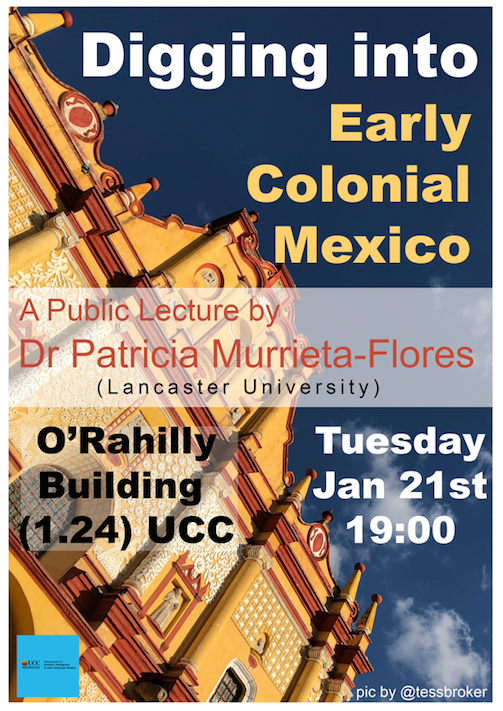Blog
Digging Into Early Colonial Mexico and Geographical Information Systems and Research in the Humanities. Two Lectures by Patricia Murrieta Flores

Join us for two upcoming lectures.
Digging into Early Colonial Mexico: A large-scale computational analysis of 16th century historical sources
Tuesday 21st – 19:00 – O’Rahilly Building 1.24 (CASiLaC Room)
The history of the fall of the Aztec Empire and the subsequent emergence of the Viceroyalty of New Spain after the Spanish ‘conquest’ in the early 16th century is fascinating. Over the last two centuries, much research has been carried out looking to explore a diversity of questions regarding the events that resulted from the clash and encounter between, not only the Spanish and the Aztec, but also the multitude of cultures living at the time in what is today Mexico. Most of this research has relied in the traditional methods of history, archaeology and anthropology. Modern technologies and the development of novel computational methods including Artificial Intelligence are allowing us to explore historical information in an unprecedented way. In this talk, I’ll introduce the project called ‘Digging into Early Colonial Mexico’, in which we are developing methods and techniques to identify, cross-link, extract and analyse information from one of the most important historical corpora for the study of the period of the contact between Americans and Europeans: the 16th century Geographic Reports of New Spain. Using ground-breaking methods and theory from Corpus Linguistics, Natural Language Processing, Machine Learning and Geographic Information Science, this highly interdisciplinary project involving geographers, historians, archaeologists, and computer scientists, is transforming the ways in which we study and analyse historical corpora.
Geographical Information Systems and Research in the Humanities
(Part of the Spatial Humanities CASiLaC Research Cluster)
Wednesday 22nd 13:00 - O'Rahilly Building 1.24 (CASiLaC Room)
The field of Spatial Humanities has substantially advanced in the past few years. From the use of GIS to the development of Geographical Text Analysis, the exploration of space and place in the Digital Humanities is emerging as an exciting arena. In this talk, I will introduce some of the most recent advances in the field including cases in history, archaeology and literature.
Speaker Bio
Dr Patricia Murrieta-Flores is the Co-Director of the Digital Humanities Hub at Lancaster University. Her interest lies in the application of technologies for Humanities and her primary research area is the Spatial Humanities. Her main focus is the investigation of different aspects of space, place and time using a range of technologies including GIS, NLP, Machine Learning and Corpus Linguistics approaches. She is PI on the Transatlantic Platform (T-AP) funded project ‘Digging into Early Colonial Mexico: A large-scale computational analysis of 16th century historical sources’, and also collaborator and Co-I in multiple projects funded by the ERC, ESRC, AHRC, HERA, and the Paul Mellon Centre among others. She has edited and contributed to multiple books on Digital Humanities, Cultural Heritage, the use of GIS and other technologies in Archaeology, History, and Literature, and has published multiple articles exploring theories and methodologies related to space and place.

